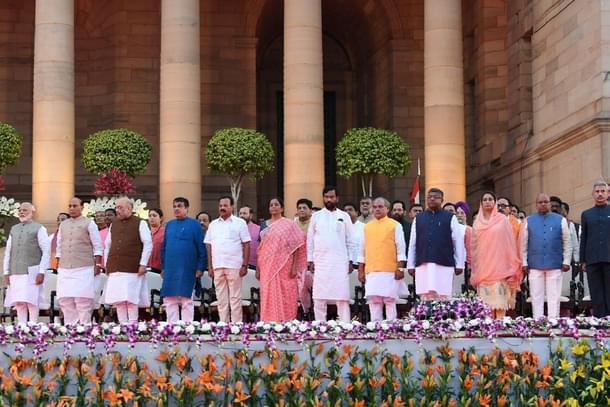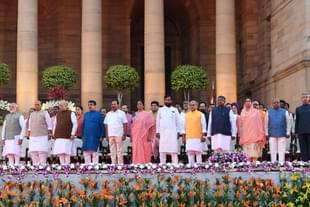Politics
The Underlying Logic Of Modi’s Cabinet Exercise Is To Create Future Talent Pool
R Jagannathan
May 31, 2019, 03:55 PM | Updated 03:55 PM IST
Save & read from anywhere!
Bookmark stories for easy access on any device or the Swarajya app.


You can also read this article in Hindi- मोदी का वर्तमान कैबिनेट भावी प्रतिभा का भी कर रहा निर्माण
In 2014, the Narendra Modi ministry was seen to be stuck for talent, with fewer than a handful of ministers with real experience, especially of the positive kind. Many asked why, with the kind of mandate he received, he did not opt for a more lateral induction of talent?
The answer comes with his new ministry, which took the oath of office yesterday (30 May), where as many as 23 new faces were inducted even as many old hands walked into the sunset, or were quietly dropped.
In one line: what Narendra Modi is doing is creating additional bench strength for the long term, by blooding new and untested talent from all the geographies, where Bharatiya Janata Party (BJP) won handsomely. If Modi wants the BJP to remain the primary pole of politics, as seems likely, his legacy will have to include not only what he did in the terms he served as Prime Minister, but what kind of experienced ministers he has left behind who can serve the party and nation in future years.
While some serious loss of talent like Arun Jaitley and Sushma Swaraj was unavoidable, the exit of experienced war-horses like Suresh Prabhu, Maneka Gandhi and Jayant Sinha cannot be explained purely by assuming that Modi didn’t like their work, or their politics.
Modi also clearly believes in hiring lateral talent in small doses, with his first term blooding experienced former bureaucrats like Hardeep Puri and R K Singh, and former army chief V K Singh. This time he went for the big hit, by inducting S Jaishankar, former foreign secretary who has handled both the US and China (during the Doklam crisis), in the cabinet.
Now consider the kind of experience he has already created, and will continue to create in the next five years. Apart from the old Sangh faithfuls like Rajnath Singh and Nitin Gadkari, Modi in his first term has created over-achievers like Piyush Goyal and Dharmendra Pradhan, and potential performers like Smriti Irani, Nirmala Sitharaman, Ravi Shankar Prasad, S Jaishankar and Prakash Javdekar, among others.
And then, of course, there will be Amit Shah, now not only a top-class manager, but a potential game-changer in government, no matter which portfolio he gets.
By the time Modi completes his second term, few observers will be left with the feeling that the BJP has no talent pool. We talk of the Congress of having a large talent pool not because many are really talented, but because we have seen them surface as ministers repeatedly.
Modi’s choices of new faces to man his ministries in junior positions is actually the kind of thing a venture capitalist would do. He knows that for every 10 investments he makes, five will be duds, two may be so-so, two may deliver well, and one may be a multi-bagger.
With 23 new faces, this means at least two future ministers will be high-flyers, and another four or five will get very useful governance experiences. The rest will be written off over the next two years if they underperform. And Modi is a tough taskmaster.
Some will also be future chief ministers. Dharmendra Pradhan clearly will head to Odisha once Naveen Patnaik falters or retires. Gajendra Singh Shekhawat will probably be groomed for a top job in Rajasthan, whenever Vasundhara Raje looks like making an exit, and Kishan Reddy will be given a bigger role in Telangana, once the TRS star starts waning. One cannot rule out Smriti Irani for a top job in some state too.
Over the last five years, Modi has blooded previously unknown names as state chief ministers, including M L Khattar in Haryana, Raghubar Das in Jharkhand and Devendra Fadnavis in Maharashtra. All three have delivered their states to the BJP — in states that the party was not No 1 earlier.
In terms of bench strength, we also have future PMs, including Amit Shah, Devendra Fadnavis, Nitin Gadkari, Yogi Adityanath, and older hands like Shivraj Singh Chouhan.
The BJP now has talent ammo to spare, including Hemanta Biswa Sarma, who is surely not only a future chief minister of Assam, but a potential Union minister.
Clearly, the BJP under Modi does not see itself as a transient phenomenon in national and regional politics. This is the underlying message of the cabinet exercise, even though more mundane explanations like regional representation and caste signalling can also be found.
Jagannathan is former Editorial Director, Swarajya. He tweets at @TheJaggi.





